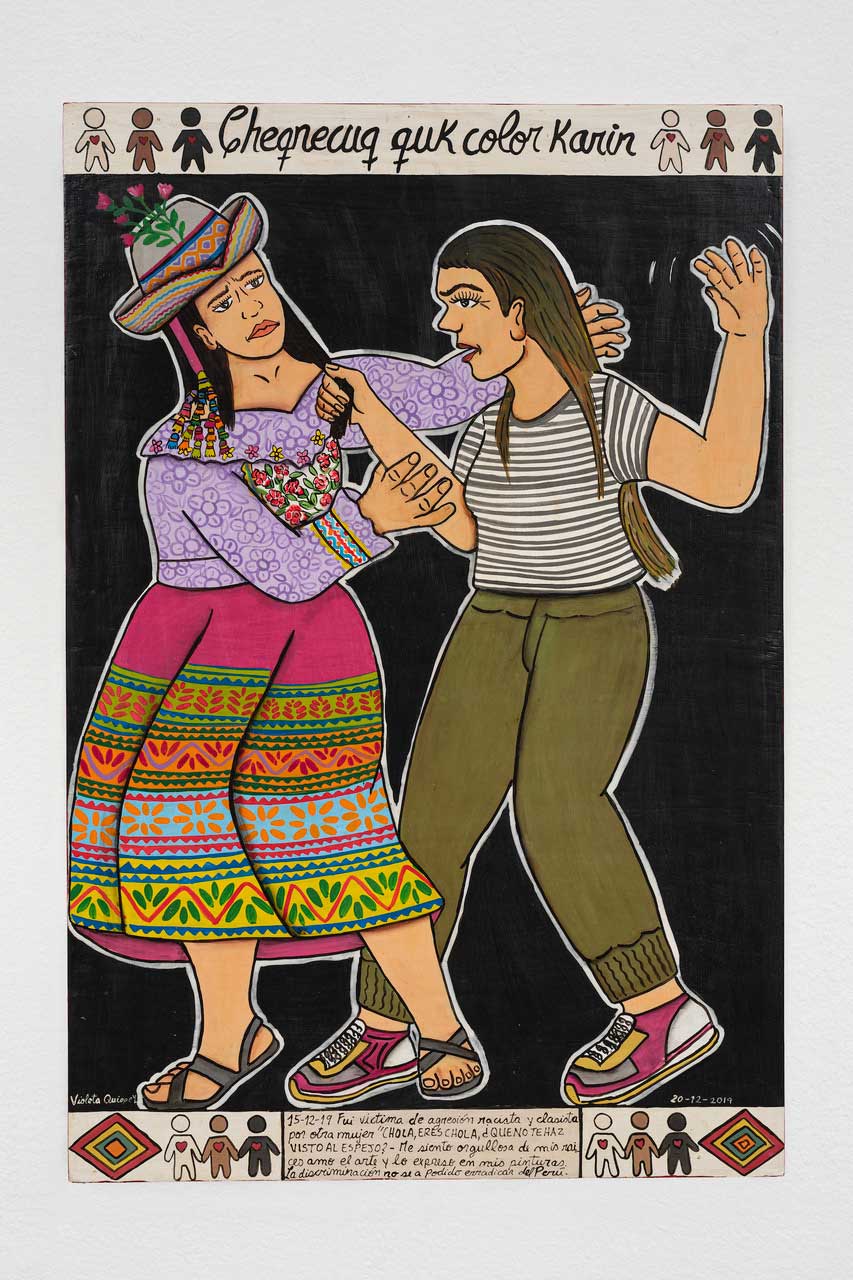


Violeta Quispe Yupari Chejnecuq quk color karin, 2019. Courtesy Galería _VIGILGONZALES
Indigeneity has been a fundamental component of artistic expression in Latin American art. It has served as both a subject for visual representation and as a means of asserting ethnic identity and creative authorship. Within this framework, the concept of indigeneity has been utilised as a political tool to shed light on stories of deprivation, discrimination, racism, and the marginalisation of individuals and communities. It has played a crucial role in shaping national identities in the Americas, serving as a means of differentiation from Western cultural hegemonies.
The incorporation of pre-Hispanic heritage, ancestral knowledge, Andean or Mesoamerican objects, beliefs, rituals, and the distinctive natural and geographical landscapes are recurring themes in the definition of Latin American art. Historical examples include the paintings of eroticised indigenous bodies by Saturnino Herran, a late 19th century artist of mixed Indigenous Mexican and Swiss descent; the use of geographical and pre-Hispanic motifs in the works of Rufino Tamayo, a modern Mexican painter of Zapotec heritage; the indigenous movement within Mexican muralism at the turn of the 20th century; the post-modern performance art integrating Afro-Cuban traditions by the Cuban artist Ana Mendieta; and the acclaimed work of contemporary Chilean artist Cecilia Vicuna, who incorporates materials, and practices from living and pre-Hispanic Andean cultures. These artists are considered canonical figures in the history of art in Latin America.
It is common to encounter contemporary Latin American works at the Feria Arco in Madrid —where the presence of Latin American artists, galleries and curatorial frameworks is particularly strong and recurrent. Cultural and socio-political themes surrounding colonial histories, critically affirm the concept of indigeneity at the fair. The works that resonated with me the most were those that conveyed their political power and emotional depth, thereby continuing or expanding upon their historical legacy. These artworks crudely yet beautifully communicated urgent messages about present-day realities while remaining rooted in their cultural and aesthetic heritage.
The ‘Sarhua Boards’, created by Peruvian artist Violeta Quispe Yupari and exhibited by the Vigil Gonzales gallery, consist of paintings on elongated wooden boards. These artworks, resembling children’s illustrations in their raw yet didactic style, narrate visual stories of families and communities in a manner akin to intimate and personal diaries. These narratives are characterized by their direct and literal portrayal of themes related to gender inequality, policing queer sexualities and the proliferation of violence against Andean women. Through these pieces, the artist sheds light on persistent social issues and stimulates awareness of these covert realities.
At the Dos de Mayo Art Museum, I had the opportunity to attend a performance by the Quiche author María Us, as part of Ana Gallardo's exhibition 'Tembló acá un delirio'. This exhibition, similarly, delves into the theme of violence against women within the colonial and patriarchal context of the Global South and its various geographies. During the performance, Us dressed in traditional indigenous attire, and recited a melancholic yet heartfelt piece that touched upon the disappearance of women's bodies. The kidnapping of mothers, daughters, grandmothers, and sisters within her community resonated amidst the ongoing political reality of the Central American guerrilla regime. The text not only conveys the profound sorrow stemming from these losses but also amplifies their absence in the hills, rivers, and paths once crossed by the author and these beloved, missing women.
Additional artists contributing to this tradition include Chilean artist Patricia Dominguez, represented by The Ryder Projects, whose work delves into ethnobotany and healing practices. Dominguez's painting, featuring flowers with human-like eyes and machine elements, is set against a cosmological a-temporal backdrop. The work explores the spiritual revelations and material transformations stemming from ancient Andean shamanic rituals, such as the consumption of plants like ayahuasca. Denilson Baniwa, born in Barcelos, in the interior of Amazonas in Brazil, exhibited with A Gentil Carioca gallery. Baniwa employs vibrant, figurative, and fantastical imagery infused with historical references that examine the enduring impacts of colonialism. Through his images, he highlights indigenous resistance and survival strategies, shedding light on the rich cultural heritage of his community.
The practice, theme, and concept of indigeneity remain a significant and relevant resource in art, transcending the Latin American context and resonating in a global contemporary context. As a Mexican migrant woman in the Western world myself, the re-encounter of these aesthetics, discourses, and realities—so present and pressing in Latin American countries— was hard. These artworks, which are an extension of traditions, and ongoing discourses, act as political tools, expressing grief and anger. They also transport viewers to a spiritual plane, connecting with the water, land, ancestors and people who inhabit other geographies and other realities that are simultaneously occurring while we live on this planet.
Paula Zambrano
Curator of Programmes